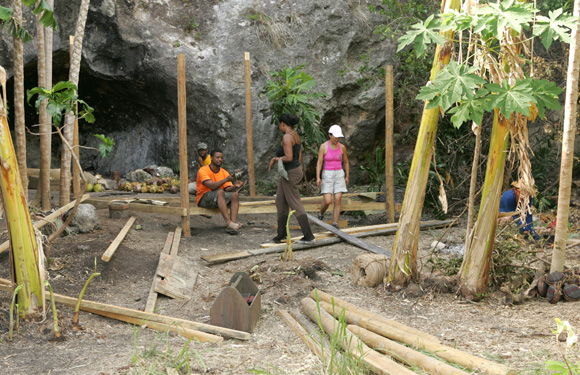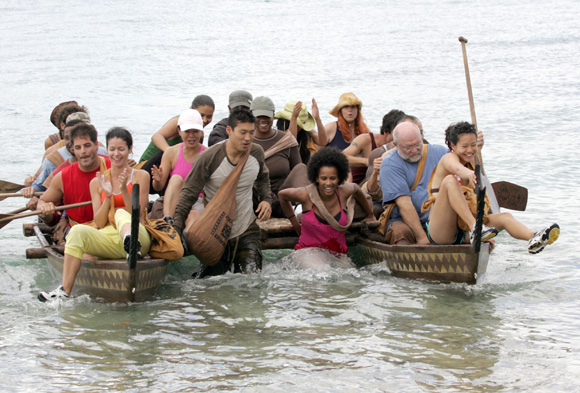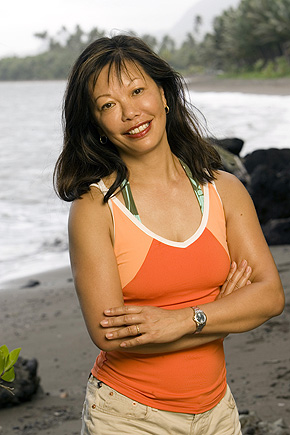
Sylvia Kwan, one of the founders of the San Francisco-based firm Kwan Henmi Architects, was spotted by casting agents for the television show Survivor in a Los Angeles restaurant. Although she scoffed at the idea when first approached, her family convinced her to try out. Building an elaborate structure was part of the show, but the design review process wasn’t especially difficult. Indeed, her expertise at leading the process may have resulted in her early departure from the show. In that way, reality TV doesn’t reward leadership. Nevertheless, she doesn’t regret the decision to participate. Kenneth Caldwell, a writer and communications consultant based in San Francisco, sat down with her to relive some of her experiences and see what lessons there might be for architects and everybody else.
arcCA: It’s fairly unusual for architects to be on television. We’ve seen them portrayed just a few times in sitcoms; Mr. Ed and The Brady Bunch come to mind. You were the first architect on Survivor right? You were representing a profession of well over a hundred thousand to some twenty million viewers. How do you think you came off?
Sylvia Kwan: Some of the other contestants said I was bossy, but I think I expressed leadership skills when they were needed, which was what it took to get the village built so the whole enterprise could begin. In a very basic way, I think I showed that architects can organize people around a good cause.
arcCA: What was your role in building the shelter, and what did you change?
Sylvia Kwan: Normally, the architect creates the site plan, develops the program, and designs the building. In this case, the drawings that we received were pretty much working drawings. They had the site plan, floor plans, roof plan, and kind of a structural plan.
Someone said, “Oh, well, Sylvia’s an architect”—and I said, “Yeah, I’ll take a look at the plans.” And then I said, “It’s fine that I’m an architect, but are there any contractors out there?” Because we had just met, remember. And that’s when Gary, Papa Smurf, raised his hand. And he said, “Oh all photos courtesy of CBS yes, I’m in construction.” What you didn’t see on the show was that he told me he hated architects.

arcCA: An auspicious beginning. The theme of this issue is design review. Can you comment on that in relation to building the shelter?
Sylvia Kwan: I began pacing the site to measure it. The site plan showed that the shelter should be right at the mouth of the cave. We walked around and realized that the mouth of the cave probably was solid rock, and that’s when we decided that we had to move the shelter away from the cave in order to get the supporting poles in the ground. We didn’t know whether we had to adhere strictly to the set of plans, so I was nervous about the change. It turned out that there were a number of mistakes throughout the set of plans that required changes.
arcCA: So one of the first things you did was make a site adaptation! What other changes did you make?
Sylvia Kwan: The kitchen didn’t work where they had put it. It was a good reminder to really study a site and spend time with it. I changed the kitchen location, but I set it—you now know my favorite word—orthogonally. I was really teased for that. I set it in a very symmetrical pattern around a central courtyard. The fire pit was built in the wrong place and we moved that. I kept thinking, “Maybe they are going to grade us on how beautiful this village is.”
arcCA: You’re kidding.
Sylvia Kwan: For example, there were palm fronds that were already knit together for the roof. There were no directions that told us one thing or another. The only clear instructions were, “If you don’t finish this village, the game will not start.”
I reviewed the drawings for a number of things. Number one, where was the prevailing wind coming from? That’s one of the first things that you have to know in an island environment, is that the prevailing wind is a big factor in comfort or total discomfort. So I checked the tops of the trees and the way the palm trees were bending. I wanted to make sure that the shelter roof line responded to the direction of the prevailing wind to protect us from wind and rain.
The second thing I checked was the direction of the sun and how it would come from morning to afternoon, to make sure that the shelter was going to be in shade during the hot parts of the day, and then in the evening the breezes would come through and cool it.
The third thing I checked was that it was very important for the shelter to be level. And thank God, they gave us a level.
arcCA: Did your fellow tribespeople get into reviewing the design?
Sylvia Kwan: Since only a few of us knew anything about building, no. But there were some suggestions about things that we could add to the design to make life more pleasant. For example, we added two horizontal ropes that were used for a clothesline and also some nails to hang things on, but I had to remind them to place them above eye level so they didn’t hurt themselves. In that way, it was similar to reality. The architect figures out the idea and the design review process influences the details.

arcCA: Looking back, do you see yourself then as the leader of that effort, and was that maybe a negative thing in the context of the game?
Sylvia Kwan: I learned that what it takes to be a good architect is not the same as what it takes to win a reality TV show and end up being the final survivor.
arcCA: So, the very characteristic that has allowed you to succeed in practice is something that maybe isn’t valued in entertainment. Can you talk a little more about reality versus a reality show?
Sylvia Kwan: All the things that matter in real life and that distinguish you and make you a special person, whether you’re a natural leader or you’re talented or you’re respected for whatever you do, or you’re older and maybe wiser, all those things don’t matter as soon as you pass through the “Alice in Wonderland” door of Survivor. Suddenly all of those things can become a liability.
arcCA: What did you do to prepare for the reality of this non-reality?
Sylvia Kwan: I trained a couple of times with a Boy Scout troop leader to learn how to build shelters, how to lash poles with vines, how to start a fire, and how to identify what’s edible and what’s poisonous.
arcCA: You did this on your own?
Sylvia Kwan: Yes. I was prepared for a much more rudimentary kind of shelter. My husband Denis was also a Boy Scout, and he taught me a lot. We actually built a half-scale model of a shelter on our front lawn. I felt confident that I knew how to build a shelter. But of course, I got there and all that was out the window because of the plans they gave us.
arcCA: Do you think your participation in the show will change or influence a broader public perception of architects?
Sylvia Kwan: I think if you look at the show that I did at Survivor Live, you will hear Jeff Probst, the Survivor host, say something complimentary like, “I cannot think of a single survivor that’s had more influence at the beginning of a show—to get the show rolling—than Sylvia did because of her experience and expertise as an architect, to build this very complicated shelter and village.” I think the public can take away different things from this show. Architects can be practical, they can exhibit leadership, and some of them are women.
arcCA: I think most people understand that architects are involved in aesthetic decisions in designing the building environment. But what else do you think you showed?
Sylvia Kwan: In one way it gets back to basics: health, safety, and welfare. Even in a strange environment like Survivor, those factors come into play.
I think that viewers are going to get that an architect is an organized person who has the ability to visualize. We can put something on a piece of paper and make it a three-dimensional reality, something that looks good, is structurally sound, and protects you. One of the best things about this particular season is that it shows a real architect doing a real project instead of the faux architects you see in movies and on TV. A realistic portrayal of an architect in popular culture has finally been made, albeit by accident.

arcCA: What was your biggest personal challenge?
Sylvia Kwan: Learning to swim. When the casting people approached me in a Los Angeles restaurant, I said, “No, I can’t even swim.” I took lessons, but I really learned when I fell in the ocean because our raft capsized. That was before the show actually began, when they were taking footage of us paddling around the islands. I actually felt exhilarated, because I didn’t panic and was able to swim safely over to the larger boat.
arcCA: How has being on this show influenced your practice?
Sylvia Kwan: It’s a great way to connect. Many of my old clients are eager to talk to me and find out what it was really like. I think our clients are fascinated by how architecture really played a role in this event. I’ve been asked to speak at a professional conference on the topic of building alliances. Isn’t that funny? I think some of the aspects of the show that are not like reality nevertheless actually underscore what is important in practice now. We have to be allied with contractors from the outset, whether it is design/build, CM at risk, or negotiated bid. When I see a logical alliance that’s going to make total sense, and everything just falls into place, we will pursue it. One way that the show changed me, and in turn the practice, is that now I know not to fight so hard. You know, if something isn’t meant to be, it’s not meant to be. I used to knock my head against the wall. If it is a square peg in a round hole and you can’t make it fit, move on, or re-engineer it later after a hiatus and everybody can take a breather.
arcCA: How did going away for seven weeks affect your firm?
Sylvia Kwan: The absence continued something that the firm had already begun. If I had been the CEO, like I used to be, it would have been impossible. We are in the process of transition and making new partners. This was a great opportunity for them to take care of their market area without me hovering around as the go-to person.
arcCA: So, it was a good thing in terms of succession.
Sylvia Kwan: Just like me learning to swim.
arcCA: What else did you find out about yourself?
Sylvia Kwan: What I took for granted as positive traits maybe aren’t necessarily all they’re cracked up to be. Those traits don’t benefit you necessarily on a show like this. I found that I could not be deceitful, even though I said I could be for the show. After the second episode aired, my son called me and said, “Mom, my friends and I were saying how clueless you were.” And by that he really meant guileless. Before this show, my idea of camping was to visit our friend’s rustic ranch and stay at the nearest inn. I found out that if I am ever on a deserted island, I probably could survive. I could find food. I could make a fire. I can build a shelter. That kind of knowledge has given me a whole other kind of confidence.
arcCA: Even though you got voted off after the third episode, tell us about a positive moment.
Sylvia Kwan: It sounds sort of hokey, but after we finished the shelter, people began to sing. That reminds you about the power of architecture, even humble architecture.
Originally published 2nd quarter 2007 in arcCA 07.2, “Design Review.”





